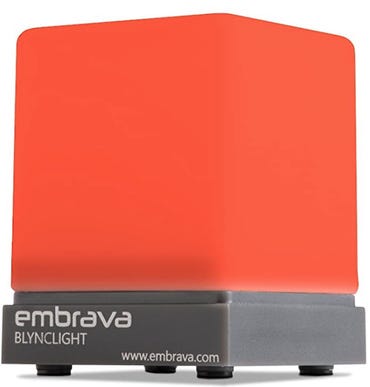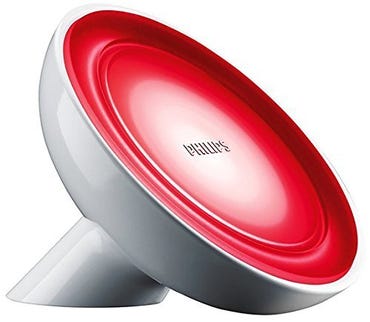Focus interruptus: The best defense against work-from-home distractions | ZDNet
I currently use inexpensive remote control LED puck lights to signal that I am not disturbed.
Jason Perlow/ZDNet
I’m sure the following scenario will be familiar to many of you working from home.
You’re frequently on Zoom, Teams, Google Meet, or other audio/video calls. Or perhaps you need to remain focused on your tasks for hours at a time. You may wear headphones for privacy or isolation.
However, working this way, it’s hard for someone in another room to know when you are on a call or are focusing. Many of us work from a home office, which could be in a multi-purpose space, such as a bedroom or living room, that others may also use, so you don’t necessarily have exclusive access to that space.
Eventually, the dreaded thing happens — a family member walks into the room and interrupts you when you are in focus mode or on video or audio with other people.
Some remote workers may have established a protocol with their housemates and family, such as being told not to open a door without knocking. And this might work some of the time, but not all of the time. In my case, my wife frequently comes in to check on me for various reasons. More often than not, I am wearing my
AirPods Max headphones
and she can’t hear what is going on, and — because of the noise cancellation — I can’t hear her coming either. Additionally, until she walks up to my desk, there’s also no way for her to know if I am on a conference with other people.
Existing business presence solutions

The Embrava Blynclight
Amazon
Work from home interruptions are so commonplace — barking dogs, screaming and crying children, and doorbells going off from deliveries — that we’ve become accustomed to them and accept them as a price of dealing with this pandemic. But we still want to minimize them, if possible.
Ideally, it would be good to have some sort of presence indicator or “On the Air” light that can alert someone approaching your office space that you don’t want to be disturbed.
There are, of course, various manual “
On Air
” lights that resemble the kind that existed in TV and radio studios in decades past, but most of them require mounting in a convenient area near an electrical source. There are also
hangable signs
but that isn’t entirely foolproof because if someone isn’t looking at the doorknob, they can easily bypass it. And even if they are mountable on the door at eye level, it’s also easy to forget to hang one of these up or to
slide it into the “DND” position
.
My solution right now is mounting a cheap
wireless-controlled puck light
on my front door with double-sided adhesive. It uses three AAA batteries that last about 50 hours. That’s not ideal — I’ll probably have to replace those batteries once a month, and I also have to remember to turn the lights on and off between calls. They do have rechargeable ones, but the charge on those products doesn’t last very long.
As far as tech products go, there are “presence indicators” such as the
Jabra Evolve
headphones that will light up red while in use (as they are conference software-aware) to alert the approaching person that you shouldn’t be disturbed. There are also USB-connected presence lights such as the
Kuando
or
Blynclight
but unless you are using a long USB extension cable to mount these outside your office, said interrupter(s) are already in the room with you and have probably disturbed you already.
These products were originally designed for larger shared working spaces, such as cube farms, not home office scenarios. There are a few wireless, rechargeable devices on the market, such as the
Luxafor Bluetooth
, which can be mounted outside your office and are integrated with conferencing systems and calendar schedulers. Still, these two products are either poorly reviewed or are no longer available.
Home automation jury-rigged solutions

Alexa and other home automation systems can control the Philips Hue Bloom multicolor LED lamp.
Philips
There are some ways to jury-rig this by using a combination of home automation components and smart assistant/speaker devices, such as with Amazon Echo/Google Home/HomePod Mini and with smart switches, and smart bulbs/smart lamps. The
Echo Glow
may not be a bad solution if you can put it on a table outside your office and you are an Alexa household, and Philips Hue has the
Bloom
and
Flourish
that may also fit the bill.
Zigbee-based smart bulbs
also might not be a bad idea, as long as they are connected to a compatible smart hub.
Current-generation
Amazon Echos
and also
Eero 6/Eero Pro mesh Wi-Fi
units have Zigbee hubs built-in. With this, you would need to run a custom routine such as “Alexa, On the Air,” which would turn the bulb on and set it to the desired color (red), and a corresponding “Alexa, I am free” that would set it to green or turn the bulb off. You could also do this with a smart plug to use
LED dumb bulbs
of different colors on
standard floor lamps
. Current Hue devices on the market, including their smart bulbs, can also be used as Zigbee devices directly, without a Hue hub.
However, this solution is entirely manual; it isn’t integrated with calendars or conference software – yet. I’d like to see an Alexa skill that combines this somehow so that if I have a block of time marked off as a conference call, it will set the status red on the light. Perhaps this can be achieved with a service like IFTTT, but I’d rather see an out-of-the-box solution.
My dream work presence device
Here is what I think a lot of folks, including myself, would want to see built:
- A device the size of a large smartphone that can be easily mounted to the front of a door or on the wall of an adjoining hallway, such as with a magnetic bracket
- The device would have a large enough (2″-3″ across) array of LED lights for 3-4 colors (Red, Green, Yellow, Blue), which would be visible from 15-20 feet away, that could be behind a larger transparent diffuser. A programmable LED message screen would be nice but not required.
- An optional motion sensor would cause the device to light up when someone was approaching rather than running all the time (for battery conservation). It would also alert the remote worker that someone was coming via push notification.
- It would have at least 100 hours of battery life before recharge.
- Fast USB-C/Qi rechargeable with AC adapter for wired use.
- Wireless controls with Zigbee and Bluetooth Low Energy, so that it could be integrated with multiple vendor home automation systems and also direct device controlled (Smartphone, PC/Mac) and with a simple desk remote.
- Open-source API development kit.
- Out-of-the-box integration with Zoom/Microsoft Teams/Google Meet and Google Calendar/Apple Calendar/Outlook integration.
- Alexa/Google Home/HomePod integration.
This is a new category of product that I would love to see a company like Poly, Jabra, Microsoft, or even Amazon itself create. What do you currently use to stop home office work interruptions? Talk Back and Let Me Know.
For all the latest Technology News Click Here
For the latest news and updates, follow us on Google News.
